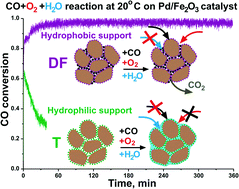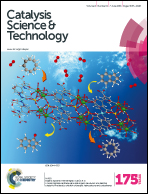Highly active and durable Pd/Fe2O3 catalysts for wet CO oxidation under ambient conditions†
Abstract
Pd/Fe2O3(FeOOH) catalysts were prepared in different ways: T – traditional incipient wetness impregnation (IWI) from a solution of palladium nitrate, D – modification of the support surface by dimethylformamide (DMF) prior to IWI, and DF – variant D followed by treatment with a sodium formate solution. These catalysts have been tested for CO oxidation under isothermal conditions at 20 °C in the presence and absence of water vapor and characterized by XRD, TEM, XPS, H2-reduction and adsorption methods. The Pd(T)/Fe2O3 catalyst is highly active in CO oxidation at room temperature under “dry” conditions but is deactivated in the presence of water vapor. The Pd(D)/Fe2O3 catalyst is inactive in low-temperature CO oxidation, whereas Pd(DF)/Fe2O3(FeOOH) catalysts are characterized by high activity at room temperature and ambient humidity. The main state of palladium in the Pd(T)/Fe2O3 catalyst without pretreatment with DMF is in nitrate complexes, where it can be readily reduced to form clusters ∼1.5 nm in size. In the case of Pd(D)/Fe2O3, palladium interacts with dimethylformamide forming complexes which cannot be reduced by hydrogen at room temperature. It is proposed that palladium clusters are located within the interdomain boundaries of the hydrophobic support in (0.5–1.0)% Pd(DF)/Fe2O3 active catalysts. These (0.5–1.0)% Pd(DF)/Fe2O3 catalysts were active towards CO oxidation at ambient temperature and humidity for several hours.


 Please wait while we load your content...
Please wait while we load your content...